| |
|
|
| |
:: September 12th - October
30th - New Zealand &
Australia::
|

NEW ZEALAND
October 5 - 23 |
|
|
|
|
|
Oct 5/6/7.
Left Los Angeles on a Qantas flight at midnight, reaching
Auckland in 12 & 1/2 hours, arriving (because of the International
Date Line) morning of Oct 7. I was met by
Lib Steward, a painter, who was a good friend in Fish Hoek.
Lib and her husband John migrated four years ago, because
their son and daughter and their families live in Auckland.
They showed me much of the North Shore, where they live. Many
South Africans live in Auckland. I even saw a shop, "South
African Kaffee", which stocked goods that South
Africans crave - Mrs. Ball's chutneys, biltong, Rooibos tea....and
we had good talks, comparing life in NZ and in S.A. An early
night, after sampling some excellent NZ wines.
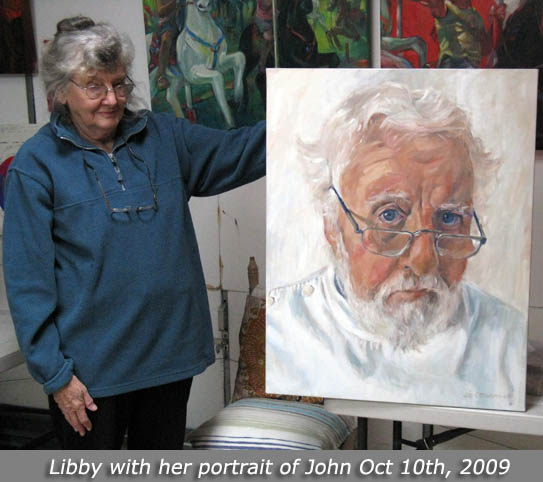
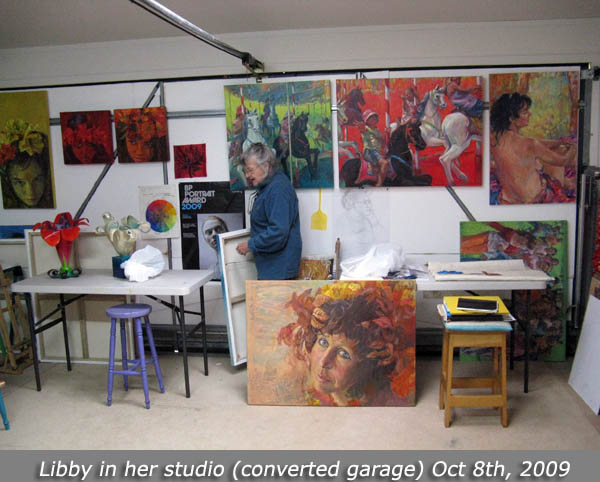
Oct
8. Lib and I had an early walk, many hills and valleys,
good exercise, and good views of patches of forest. I was
glad to see many Pahutakawa trees (Metrosideros
excelsa - New Zealand Christmas tree), a common sight
in Fish Hoek. Lib is still very active painting and teaching,
and producing large colourful paintings, very arresting. I
loved going to sleep in a room with her work on the walls.

I was collected by Eric and
Jo Hanley, who had driven (660 kms) from Wellington, to meet
me. (I was overwhelmed when they suggested this). We drove
to Rotorua, spending the night at their favourite Oak Tree
Cottage, one of the most comfortable B&Bs I know, with
magnificent views over the lake. After seeing the well-curated
museum, we went that evening to a Maori cultural event, which
was well done, ending with a traditional dinner. Although
it was certainly "touristy", 150 tourists
being entertained, it did convey a good sense of aspects of
Maori culture.
Oct 9. There
had been a severe snow storm in this area a few days earlier,
with nearly 700 cars being stranded, and we were not sure
whether we could get through. On my morning walk, I was glad
to see that the skies were fairly clear, and fortunately,
the roads were open, After a look around Napier, "the
Art Deco City" I was deposited in Havelock North
with Pete and Bev Harrison. Pete is the younger son of my
sister-in-law Lizzie; they and their children (Andrew, 20,
Amy and Tom, twins, 17) migrated from Zimbabwe seven years
ago. Eric and Jo kindly allowed me to spend two days with
Pete and Bev, while they went their separate way.
Oct 10.
I have been so lucky in often having some-one to accompany
me on my morning walks; Bev showed me her neighbourhood, including
the small town of Havelock North, while it was still fine.
Later, we dodged rain showers while we had a closer look at
the Art Deco buildings in Napier. Pete drove us to see several
vineyards in the extensive Hawkes Bay region.
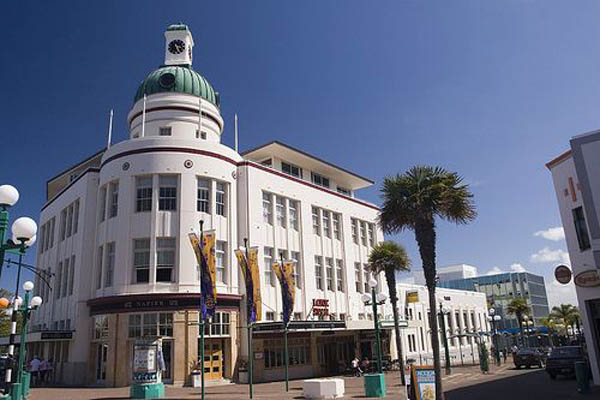
Havelock North, Hawkes Bay
region: While walking around, it was distinctly chilly, and
Pete thoughtfully bought me a pair of woollen gloves, which
I wore, gratefully nearly every day during my stay in Aotearoa.
(Eric, guessing that I would be unprepared for the cold weather,
kindly lent me a warm jacket, which I kept for the duration
of my stay; without this covering, I would have suffered.)
I had commented that, in contrast to the Cape, there seemed
to be little difference in the size and quality of houses,
so Pete and Bev drove me to see what they considered the worst
and the best groups of houses.. Bridge Park was at the low
end of the scale: the homes were modest but adequate (they
would have been among the best in most African townships)
but they were not well maintained. Most of the inhabitants
appeared to be Islanders, or Maoris. At the top end, Temata
Peak, grand houses had sweeping views and extensive grounds
– but still nothing like the disparity I am used to
in South Africa.
Bev showed me Lindisfarne,
a boys’ school where she is the librarian; and she also
works with “gifted boys”, who need challenging
tasks to prevent them from being bored with the standard school
routines. The school, partly government funded, caters for
480 boys, from age 11, half of them boarders, and ranks among
the best schools in the country. I was most impressed by the
facilities.
In the evening Pete took
us all to Craggy Range Winery for another splendid dinner
– I had the signature dish, ”crayfish and
abalone with asparagus” with a fine local wine
– a Cornerstone, Cab.Sauv. + merlot + malbec. We also
shared a bottle of Pinot Noir, sourced from Otago in the South
Island.
And we finished our meal with a good Noble Harvest; Bernard
and I both enjoyed dessert wines, and this was superior. Fortunately
seventeen year-old Tom, who had been drinking coca-cola, drove
us home. (NOTE. Throughout the rest of my stay in NZ, I enjoyed
excellent meals and great wines, but I shall try to exercise
restraint , not identifying every item of every meal, not
wishing to become – as my nephew Fige would call me
– “Mr. Menu”. However, one final
culinary comment : the seafood – green-lipped mussels,
oysters, and, especially, scallops – was outstanding,
and the wines, especially Oyster Bay Sauvignon Blanc, delectable
– and better, I thought, than when I had drank this
wine outside NZ).
Oct 11, Sunday.
On my morning walk around the block (45 minutes) I admired
the “rhodos” in Pete and Bev’s garden, and
in many other gardens too. Years ago, on my visits to Bulawayo,
I had accompanied Bev to mass, as I did this day, to the local
Our Lady of Lourdes church.
I was re-united with
Eric and Jo, who collected me to take me to lunch at Mission
Estate Winery, “New Zealand’s oldest winery”
(estab.1851), for a superb lunch on the sunny terrace., looking
out at the distant snow-clad Ruahiri range. Eric then drove
us through a succession of small towns, much like Karoo towns,
passing the dramatic Manawatu Gorge, to reach their home in
Waikanae in the early evening.. I was pleased to learn that
Eric is one of the few of my friends who still makes (very
well) cocktails – we had Margaritas. We had oysters
and scallops at Drift, a restaurant on the coast, where I
was intrigued by the name of our good Syrah – Squawking
Magpie, The Chatterer, made at Gimblett
Gravels in Hawkes Bay.
Waikanae is a pleasant coastal town, (60 kms north of Wellington),
where Eric and Jo have a roomy, comfortable home, with a large
garden, which overlooks the grounds of a retirement home –
so it is like a nature reserve. I saw my first Tui,
a common and noisy bird. with its distinctive white ruff.
Oct 12 -13 My morning walk took me through
suburban streets, with colourful flowering cherry trees, and
well-kept gardens. At breakfast I was introduced to golden
kiwi fruit, which I much preferred to the usual variety. Eric
and Jo drove me around the locality, showing me mountains
and coasts, and taking me out to excellent restaurants. .I
saw many more of the colourful Pohutakawa trees.
Although I am not really “into” cars, I was fascinated
by Southward Motors, a huge collection of vintage cars –
the names brought back boyhood memories : Lagonda –
driving to yacht races with Graham Sefton - Humber, Nash,
Essex, Buick, Hudson, Willys, DKW – my dad had owned
one of each of these last two - Riley, Studebaker, Armstrong-Siddeley
– the Governor of Tanganyika, Sir Edward Twining, used
this car - Oldsmobile, Pontiac, Hillman Minx (Bernard had
one in Tanga); Standard (I drove a Standard Vanguard van in
Tanganyika). As a boy I could easily identify all cars on
the road, and seeing these models brought back my intense
interest, then, in cars. I also appreciated the early classic
cars, including a Bugatti, and a Hispano Suiza.
Then there were the motor-cycles – again the names revived
old memories – Royal Enfield, BSA, AJS, Indian, Matchless,
Rudge, Norton, Triumph. The exhibition had a display of Burt
Moore and his Indian motor-cycle, which he patiently re-assembled
to race – and win – at Bonneville Flats, in Utah,
in the 1930s. Later that evening, Eric showed a video, The
World’s Fastest Indian, (with Anthony Hopkins)
of this remarkable achievement .
Oct 14-17 Wellington. Eric and Jo drove me,
on a rainy day, to Wellington, where we had lunch at a good
downtown restaurant, Pravda, with their daughter
Abigail, now the mother of two, whom I had last seen when
she was a teen-ager, in Edinburgh. Despite the rain, we managed
to see Katherine Mansfield’s home.; as a student, I
had read nearly everything that KM (1888-1923) wrote, and
her home was a pleasure to see, We also visited the City Gallery,
to see an exhibition by the Japanese artist, Yayoi Kusama
– of whom I had not heard, though now I realise that
she ranks with Andy Warhol among contemporary artists. Some
of the installations were certainly stunning, others I found
puzzling.
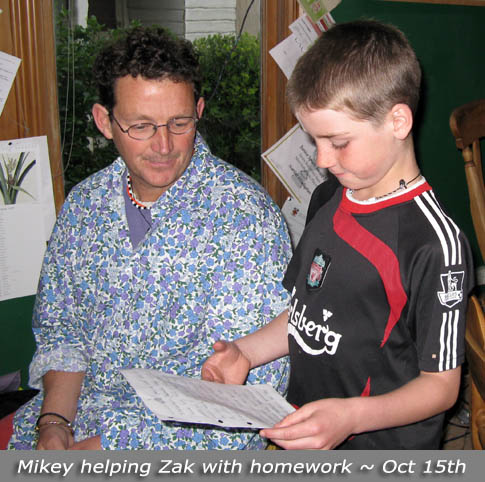
I was dropped in the suburb of Island Bay, at my next hosts,
Mikey Sansom and Cathy O’Callaghan, and their children
Scarlett (13), Keira (11) and Zak (9). I had met Mikey through
Cathy’s mother, who was a member of our parish in Sherborne.
Mike, originally from NZ, was then running an NGO, African
Initiatives, working in Ghana and Tanzania.. The family moved
to NZ a year ag0, and Mikey now works for New Zealand Aid,
mainly in Papua-New Guinea, not an easy assignment. Cath is
a nurse, working at the local hospital.
Mikey cooked our meal that evening – vegetarian fare,
very tasty; in all my NZ homes, the men – John in Auckland,
Peter in Havelock North (a spicy Thai Tom Yum soup), Eric
in Waikanae and now Mikey – cooked at least some of
the meals.
Mike & Cath’s home is near the sea, so I was able
to get a good walk along the coast, opposite the eponymous
Island, of Island Bay. One day I accompanied Mkey shopping,
being fascinated by Moshim’s Grocery Store, which had
quite the widest range of Indian spices I have vet seen, there
must have been over 200, all neatly in their little accessible
boxes. We passed the South African shop, which stocks items
essential for the expat South Africans, of whom there are
many. Stopping for coffee in the bohemian suburb of Newton,
at the Paris café (run by Frenchmen) I learnt to ask
for a “flat white”.
Mikey took the Friday
off from work, so he could drive us to the Wairarapa region,
just over one hour north of Wellington, driving on winding
mountain roads, with dramatic gorges. Noticing several signs
for “Lifestyle plots” I asked Mikey what
these were, and I am still not sure. .Arriving at Martinborough,
the rain had stopped so we hired bicycles for our wine-tasting
– a marvellous experience, I was a little wobbly at
first, but after our fourth winery, I was cycling like a pro.
The ground was level, the vineyards not too far apart, it
was a lovely afternoon, with a break in Martinborough. for
assorted breads, cheeses and olives – and the obligatory
glass of wine .We enjoyed the wines, especially some fine
Pinot Noirs (Ata Rangi and Tir Hawa). EST,
a local restaurant, proved to be surprisingly good, we had
a pleasant leisurely evening. We spent the night in Martinborough,
at the comfortable Coronation B & B.
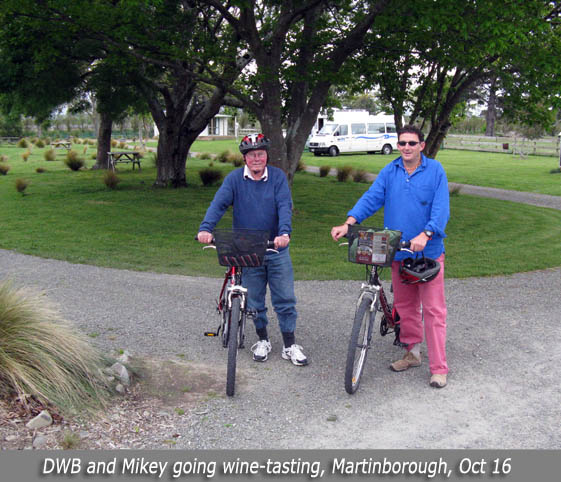
Rain fell heavily on the Saturday, so we abandoned thoughts
of driving to Mt. Bruce Wildlife Reserve, and returned home.
Keira and Zak made delicious pancakes for a late breakfast
– with golden Syrup, chocolate, cinnamon, lemon juice.
The rain had cleared enough for us to go to the fairly new
and most impressive Te Papa Museum, with wonderful exhibits
(many interactive). I liked especially those dealing with
the Maoris and Islanders. .
Seeing advertisements
for Tchaikovsky’s Opera, Eugene Onegin, showing
that evening, I telephoned the St.James theatre, but was told
that all seats were sold. At Mikey’s suggestion, we
drove to the theatre; two tickets had just been returned,
so I was able to buy one. I went by bus (20 minutes) back
to town, and in the theatre ( 1920s, a great period building)
got into conversation with the woman seated next to me, in
the other returned seat. She had spent 20 years teaching in
Harare, another coincidence. If I say that the opera was quite
as good as Cape Town Opera, I mean that as a compliment. Of
the principals, Tananya was a Kiwi, Lensky a Russian, and
Onegin came from Sussex; more important, all three sang beautifully.
When the opera ended
I took – at Cath’s suggestion, because buses were
infrequent at this hour - a taxi home. I asked the (brown
skinned) driver where he came from, and he said “I
am from Kenya” Pause, he probably thought that
I did not know where Kenya was. “That is in Africa”.
. I was able to say, in Swahili, “Yes, I know, I
lived in Kenya for two years”. He was delighted,
as was I , being able to try out my rusty Swahili. He was
actually an Oromo from Ethiopia, had lived in Nairobi for
six years, then he had been accepted as a refugee in NZ. (“a
good country, peaceful”.) I guess that as a member
of an oppressed minority in Ethiopia, he appreciated the peacefulness.
Tipping is not customary in NZ, but when he dropped me I had
to give him a generous tip, saying : Haya, Bwana, umekutana
kwa bahati, sasa ni bahati njema yako..Nenda kwa Mungu. (“So,
we met by chance, now it is your good fortune, God be with
you.”) That conversation rounded off a marvellous
evening., and It also reinforced my wish to travel to Arusha,
in Tanzania, in 2010, to spend some time on safari with Mikey’s
friend Daudi. Daudi is the son of American missionaries, born
in Tanzania, who runs a travel business and is involved in
conservation and human rights.

Oct 18, Sunday.
Oct 18, Sunday. Wellington and South Island. Mikey
drove me early (7 a.m.) to the ferry terminal, to board the
ferry Kaitaki, which has accommodation for 1,600 passengers
– it was a quarter full. Mikey had booked me (NZ$90)
in the “Kaitaki Plus” section, rather
like an airport Business Class Lounge, with complimentary
breakfast, newspapers and comfortable seats – even with
computer access. I enjoyed a cooked breakfast, but found no
marmalade, only Vegemite, not the same thing. A strong southerly
wind blew, but our ferry (22,000 tons) was steady, and we
were soon in the calm Marlborough sound. After a 3 & ½
hour crossing, we landed at Picton, in the north of the South
Island, where I had time for a flat white and a muffin before
boarding the train to Christchurch. I made two other train
journeys in NZ, all were comfortable, punctual and offered
grand scenery. This train (five carriages, each one with 50
seats, not full) followed the coast, a 350 kms journey, taking
4 or 5 hours, passing : Some of NZ’s 40 million sheep,
(reduced from 90 million not too long ago); cattle, horses,
one pheasant, Marlborough vineyards, estuaries, rivers, salt
pans, little ‘bachs” – pronounced Batch,
as in bachelor- small holiday homes); hawthorn in bloom, and
long stretches right on the coast, with seals on the rocks.
.
Remembering the custom which
Bernard and I followed, I bought a small (200 ml) bottle of
Lindauer Brut Cuvée, an excellent sparkling
wine, murmuring “Happy Landings”. Further
on the journey, I had a cream tea, very English.
Oct 18-20
Christchurch. Arriving in Christchurch, I was met by Gaye,
Mikey’s mother, whom I had met c 1998, in Bristol, on
the occasion of Mikey and Cath’s “Celebration”.
Gaye took me to her elegant flat right in the centre of the
city, where we tried to catch up with what we each had been
doing over the past dozen years. The next day, I walked in
Hagley park (460 acres) which is very close to Gaye’s
flat. Gaye gave me a grand tour of the city, including:
- the splendid Botanic Gardens, with huge chestnut, eucalyptus,
beech, birch as well as Kauri and other unfamiliar
indigenous trees; we admired the tulips, hebe, more “rhodos”,
azalea;
- Christ’s College, the prestigious boys’ school
which Mikey and his brothers attended, buildings, boys
and masters all very much like an English public school.
- A circular ride on the tourist tram;
- The Cathedral;
- the gondola to the top of the hill behind the city, for
a view of Lyttleton harbour.
- A drive to Governor’s Bay,
then Gaye dropped me at the Art Gallery, most of which was
too contemporary for my tastes, but they did have some fine
paintings by Rita Angus (I had not known her work, I liked
it very much).At the gallery I asked for Earl Grey tea, was
served real tea, tea leaves in a tea pot – a rare treat
these days.
That evening Gaye took me to a neighbourhood
gathering (about 18 people) at her neighbour John Boardman,
who had taught Mikey at Christ’s College. I found them
a congenial, welcoming group ,and I enjoyed our dinner at
a Thai restaurant.
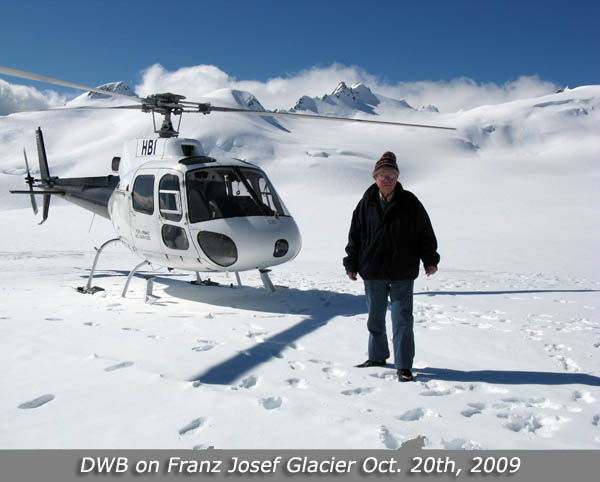
Oct 20 TranzAlpine
train, flights, Queenstown. This packed, varied day was one
of my best in the whole trip. Gaye drove me to the station
for this spectacular train ride, which crosses the NZ Alps
–as the name of the train states. Covering 230 kms,
and taking 4 & ½ hours, we crossed the Canterbury
plains, passing Lake Brunner, which I knew from Rita Angus’
fine paintings; then we climbed to Arthur’s Pass (700
m) and on to our destination, Greymouth, with the conductor
providing a good commentary on historical, geological and
social aspects. Some remarkable engineering was involved,
manouvering the train through tunnels (the longest being 5
& ½ miles long). At Greymouth, I was met by Samuel
Valor, the friendly pilot of a four-seater aircraft (the other
passengers were from Brazil), which took us to Franz Josef.
.Here we transferred to a helicopter for a short flight over
the mountains, landing on the Franz Josef Glacier. Back to
Samuel, who flew us to Queenstown, the large tourist town
of “Lord of the Rings” fame; well, scenes
were shot in the vicinity, and these locations are a big tourist
draw. Not for me.
Mikey had booked me into
Coronation Lodge on the edge of the city centre, recommended
in Lonely Planet guide.. When I asked the receptionist where
to go for dinner , she told me to walk through a little park,
and I would find myself in Main Street. For a moment I hesitated,
wondering if it would be safe to walk back through the park
at night – it was already early evening. Then I remembered
that I was in NZ , not SA, and I went ahead fearlessly, finding
yet another outstanding restaurant, Tatler’s, where
I ordered a well made Margarita cocktail, followed by scallop,
with a Central Otago ( the southernmost wine producing area)
Pinot Noir.
Oct 21 Queenstown Wellington. Mikey had booked
a returning flight in late afternoon, so I had the best part
of a day in Queenstown. In the morning I took a three-hour
Bus tour , in a double-decker London style bus – with
only four other passengers. We stopped at Bungy Bridge, (“the
birthplace of the bungy phenomenon”) where I watched
a brave (foolhardy?) young woman jump from the bridge. Queenstown
advertises itself as the adventure centre, a magnet for extreme
sports enthusiasts.
For me, the main attraction
on this bus tour was a long stop at Arrowtown, where gold
was discovered in 1862. It has an informative museum, and
the main street is carefully and authentically restored. All
very touristy, but not to be scorned, they have done a good
job.
Back for lunch at Eichardt’s,
a restaurant overlooking Lake Wakatipu, choppy, with white
horses. I enjoyed my whitebait fritters, with a Quartz Reef
Otago sparkling wine. I am having to exercise discipline not
to tell you even more about the food and wine…hmmmm.
On my flight to Christchurch
there was, remarkably, no security at all, we simply walked
on to the tarmac and onto the aircraft. After changing planes
at Christchurch, I found Mikey waiting for me when we reached
Wellington, about 9 p.m
Oct 22 Wellington. Mikey and Cath were both
working, the children were at school, so I had a free day.
I went by bus to town, for another more extended tour of the
first-class Te Papa museum, so much to see, so well arranged,
with a bright café for my morning flat white. After
asking at several bookshops, I found a short readable history
of NZ (by Gordon McLaughlan). I met Mikey for lunch at the
Concrete Bar and restaurant – a weird name, and unprepossessing
entrance tucked away in an alley, but a superior restaurant
– no tourists here, but obviously appreciated by local
business men. It was quiet (no music, this becomes increasingly
important for me with my hearing loss). Mikey and I shared
a light lunch of meze, with a glass of Oyster Bay SB. .
I wanted to take Mikey and
Cath to a good dinner that evening: they suggested one of
the leading restaurants, Logan Brown, which was fully booked.
I was not too disappointed, because it seemed too larney
(SA. - pretentious). Instead we crossed the road to a modest
Malay restaurant, which we had to ourselves ,and where we
had a jolly evening. Returning to the parking garage for the
car, I saw a poster, announcing , "CAR STOLEN",
which amused me – in Cape Town, so many cars are stolen
every day that no-one bothers to put up a poster.
I spent less than three
weeks in NZ, and I was not at all “on a fact-finding
mission”. Nevertheless, I could not help but reflect,
on many occasions, on similarities between the “Coloureds”
and Africans in SA, and NZ’s Maori and Islanders . Frequent
familiar references appeared in newspapers, and statistics
showed depressing correlations in relative scores in health,
life expectancy, education, crime, housing - in all economic
and social indicators. I read the usual explanations, varying
from blaming oppression and discrimination to “culture”.
I observed, but reached few conclusions.
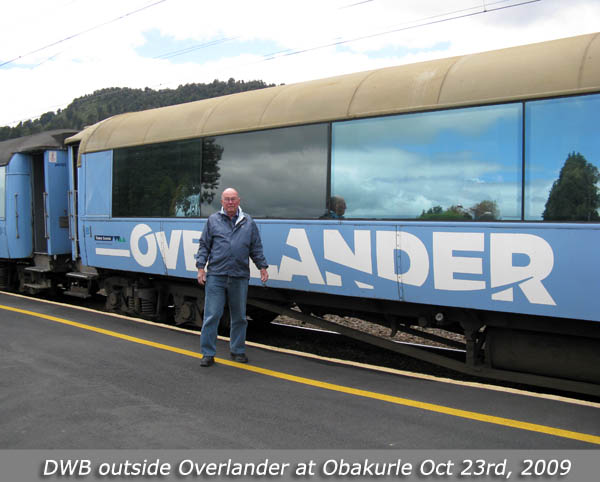
Oct 23 The
Overlander. Mikey, accompanied by Zak, drove me early to the
railway station for my journey in NZ’s premier train,
the Overlander, to Auckland. When I was settled in my comfortable
forward facing seat, Mikey brought me a Listener (a good weekly
magazine) and Zak brought me a cup of coffee: it is impossible
to get a bad cup of coffee in NZ, even at railway stations.
The 680 kms journey takes 12 hours, the same as my train ride
from, Thurso to London, but with no changes. Again we had
an interesting commentary, dispensing such nuggets of information
as: there being 352 bridges and 14 tunnels.
We rode at first along the west cost, passing Waikanae where
I had spent pleasant days with Eric and Jo, and looking out
at Kapiti Island Reserve, “the largest land mass
that is free of rats and all vermin”. We passed
Mt Ruapehu NZ’s highest (2800 m) peak, and stopped at
the ski resort of Obakurle, where I had a 20 minute walk,
instead of my usual morning walk. This was a lovely journey,
with the conductor constantly urging us to look out (either
from our seats or from an observation platform) at the viaducts,
gorges, great landscapes, forests (both exotic and indigenous)
and cattle and sheep – I noticed that the younger animals
scampered away from the train, whereas older ones simply gazed
at us, in an indolent fashion.
The trains stopped to pick up a passenger at the little settlement
of Taihape, the first stop in five years, so about 30 people,
and two reporters, were on the platform to greet the train.
Such excitement. I bought a G & T for my sundowner, then
alighted at Middlemore station, where I shared a taxi to my
Ibis airport Hotel. The taxi driver was a recently arrived
Indian, from the Punjab, who was pleasant, articulate and
also had the looks of an Indian film star. At the hotel, a
smiling Maori (?Islander) waitress brought me Scallops and
avocado, with a glass of Huntaway Reserve Pinot Gris.
---o0o---
|

Australia
October 24 – 30
|
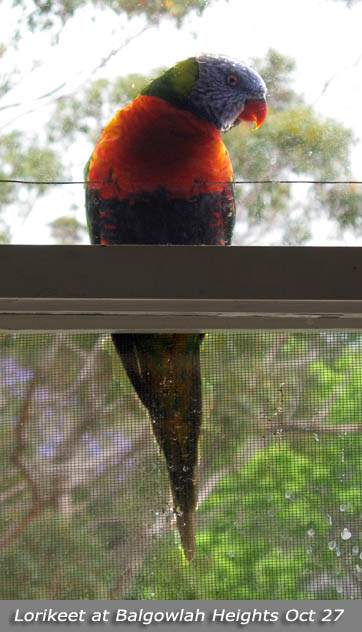
Oct 24-26 Sydney.
Despite my having made many air journeys, I always get pre-flight
jitters, a nameless anxiety, worse now that I travel alone. I
put on my reliable travel alarm, but still I woke up at 2, 3,
4 a.m., I was reassured by the comfortable Qantas airport business
lounge, where I could get my last flat white, and catch up on
my emails, On the flight, I accepted a glass of champagne (Charles
Heidsieck) feeling decadent as it was only 10 a.m .My fears dissipated
as soon as I saw the happy face of my godson, Adam Lister, waiting
for me at Sydney airport . Adam is the second son of my late Cambridge
friend Julius Lister. After doing some errands in town, Adam dropped
me at the Sydney Opera House, where I had booked, months earlier,
for a matinee performance of Benjamin Britten’s Opera Peter
Grimes – actually it was in the Opera Theatre, which,
I was told, has the better acoustics, It was a superb production,
with Susan Grisson (whom Bernard and I had heard at the Wigmore
Hall, when she won the 1994 Kathleen Ferrier Prize), singing Ellen.
At the two intervals, I came out on to the terrace, overlooking
the harbour on a sparkling clear day, with ferries, cruise boasts,
power boats and – best of all – scores of yachts ,many
of them breezing along with the wind, with their full spinnakers
out, reminding me of my yacht racing days in the 1930s. I also
saw – a less lovely sight, in my opinion - the huge cruise
ship Star Princess, which I had seen in Lyttleton (Christchurch)
and also in Wellington. On returning to my seat, I asked an usher
for directions to the toilet; he pointed me downstairs, then asked,
a little anxiously, “Will you be alright on the stairs?”.
This took me aback for a while – I do not think of myself
as 86 years old – but I gratefully accepted the usher’s
kindly concern for an elderly man.
Before catching the ferry to
Manly, I wanted to draw cash from an ATM, but was confused as
the sun shone brightly on the screen – and the previous
year, in London, I had lost a card because I misread the screen
in the sunlight. A young couple helped me: I found everyone so
friendly and helpful, both in NZ and Australia.
On the ferry I telephoned - after getting help in operating my
(borrowed) cell phone from another couple - Beatrice, Adam’s
wife, who met me at the terminal, driving me the short distance
to their home in Balgowlah Heights. Bernard and I first came to
Balgowlah forty years ago ,when we visited our friends John Burton
and Tom Searles (see below). At home I was greeted by the children,
Jason (18, busy writing exams), Oliver (16, engaged in a complex
computer game), and Isobel, (14,and still – as she was on
my last visit in 2006 - much concerned with horses, even owning
her own horse now). Beatrice is of Dutch descent, and she lived
for long in Curacao, where the whole family will go to a family
reunion, over Christmas. . Beatrice, a financial manager, thanked
me for coming (which touched me) saying I was an “honorary
grandfather”, the children seeing little of my generation.
Mikey and Cath had said much the same, which was gratifying. That
evening we had a good family dinner, Chinese Takeaway with Cloudy
Bay SB.
On the 27th
(Sunday) I walked (an hour) to Manly for mass,
a pleasant walk on a well made scenic l walkway, looking out at
Manly Bay. I passed jacaranda in full bloom, reminding me of Durban,
Salisbury (Harare) and Santa Barbara – these lovely mauve
blossoms have so often been part of my background. I also saw
a few Callistemon, which Bernard called “tree
of heaven”, when he brought me sprigs of blossom when
I was ill in Tanga hospital in 1954. The ubiquitous myna birds
were another reminder of Durban. Beatrice collected me after mass,
and at breakfast I was intrigued by the persistent , colourful
and noisy lorikeets, waiting for their handout of sunflower seeds.
I had an idle day, catching up on family activities since I had
last seen them.
In the afternoon, Beatrice and
I walked, part of the time in a slight drizzle, through Katangwa
Bushland Sanctuary, a small reserve only open on Sundays. I marvelled
at the remnants of indigenous forest, but we were troubled by
leeches. I thought that I had escaped by tucking my trousers into
my socks, but on returning I saw blood on my trouser leg, and
removed a disgusting bloated leech. Ugh! The whole family enjoyed
a good dinner at the Bluewater Café overlooking Manly Bay.
On the 28th Monday,
Adam drove me out in driving rain to Erica, 60 miles north of
Manly, to see John Burton (81) and Tom Searles,(93) whom I had
known since Rhodesia in the 1950s. They are a little frail, but
as bright as ever, and we had lunch at Caroline Bay Art Gallery,
(overlooking a marvellous Japanese garden ) drinking a Scarborough
Chardonnay from the Hunter Valley.
John told me how in 1911 his
grand-father had saved Billie Brokensha from drowning, on the
north coast of Natal. Billie later married Ellen Burton, so John
and I are distantly related. On my last day with Adam and Beatrice,
I had time for a walk along the beach, with Milo, the eager white
poodle, who left scarcely one tree unmarked. Adam drove me to
the airport, first leaving my big bag at Ibis Airport Hotel. I
was able to buy Mister Pip, Lloyd Jones‘s novel
highly recommended by Mikey, for flight reading.
Oct 27 – 29, Adelaide. Waiting at airports
was made much more comfortable when I could use the business class
lounge, then a short flight to Adelaide, where it was hot , 30
C, a welcome change after the damp and chill. Driving in my taxi
along Sir Donald Bradman Drive, I recalled how as schoolboys we
hero-worshipped Don Bradman, said to be the greatest cricketer
ever – and certainly he was more modest, gracious and courteous
than many present day sportsmen.. I stayed two days with cousin
Peter Brokensha and his wife Elizabeth. Peter gave up a career
as director of Caltex Australia to become an anthropologist, spending
more than a year with the aborigine group, the Pitjantjara, near
Alice Springs. I wondered again why Peter – and others of
my Australian cousins – pronounce our name “Brokenshay”,
whereas in South Africa we call ourselves “Brokenshaw”;
this is surprising, considering that we share an ancestor three
generations back,. Since my last visit, three years previously,
Elizabeth’s garden was flourishing, full of roses –
a great display of crimson, yellow, white and pink varieties.
.
Peter took me to the Museum and
Art Gallery, where I was impressed not only by some charming C19
and early C20 paintings, outstanding dot pictures by Aborigines
and also by the ”Nature and landscape photography”
exhibition, stunning pics. Peter walks with some difficulty, so
we took taxis, whose drivers came from Serbia, Afghanistan, India
and Greece. That evening we had dinner with P & E’s
daughter, Sally, who works with the development agency AusAID,
Volunteering for International Development . Bernard and I had
visited Sally when she lived in France, and she had come to see
us in Sherborne; because of our shared interest in International
Development, we always have lively talks. Sally was leaving the
next day for Bangladesh, and has also been working in Papua-New
Guinea.
On my last day, I spent
an hour or two at the extensive Botanic Gardens which I had last
walked though with Bernard in 1990. I was able to find a bus to
the Airport ($3.70 rather than the $25 for my taxi) and I was
soon in Sydney, checking into the Ibis Hotel for my last night.
-----o0o----- |

South Africa
|
Oct 30 – 31
Coming home.
I was a little frustrated on the long (14 hours) return daylight
flight, when the cabin crew insisted on closing all the blinds,
which I found claustrophobic, One steward told me that ”there
is nothing to see”, but I had learnt from Bernard
that there is always plenty to see – if you look. Other
passengers preferred to watch movies, or sleep. At least I could
finish two books, Mister Pip, a dramatic story, set
in Bougainville, and Jonathan Safron Foer’s Everything
is Illuminated, an engaging and poignant novel about a
young man (Jonathan?,) who goes to Ukraine in search of Augustina,
a woman who saved his grandfather’s life during WW2. The
story is told in alternative sections by the local translator
Alex, whose grasp of English is erratic, and Jonathan, who was
born 1977, and already is so accomplished, with a third novel
just published I even saw two movies, The Last king of Scotland
(I preferred Giles Foden’s original novel) and Mao’s
Last Dancer.
I arrived at Oliver Tambo International Airport, Johannesburg,
in good time for my connecting flight to Cape Town. It was due
to depart at 7 p.m., but was “indefinitely delayed”,
so, being fatigued, I chose to spend the night at an airport
hotel. British Airways recommended the Birchwood Hotel, a good
choice at Rand 800 B & B, but my Mastercard was rejected
– this was due to an error by Standard Bank, as I later
discovered. My VISA card, I knew, was of no use because I had
ran over my limit. What to do? I had only Rand 300 in cash,
but I was able (just) to scrape together enough Euros, pounds
and US $s, to make up my bill, and I had a good night’s
sleep, despite a really heavy downpour. No problems the next
morning, arriving home in Fish Hoek by 11 a.m.
Summary
I was away 107 days, visiting six countries – Britain,
Ireland, France, USA, NZ and Australia. I had stayed in 24 homes,
and spent six nights at hotels – Biriatou, (inland from
Biarritz, in the Pyrenees-Atlantiques), Inverness, Queenstown,
Auckland, Sydney and Johannesburg. I made 27 flights, and also
travelled by car, bus, train , ferry and bicycle
This truly was “the
trip of a lifetime”, thanks - as I told them - mainly
to my friends and family, who welcomed me so warmly and with
such consideration, and who:
- met me at the airport, or the railway station, or the ferry
terminal;
- provided me with comfortable accommodation;
- wined and dined me magnificently;
( I had so many memorable meals, and good wines, both in homes
and at excellent restaurants)
- drove me to many interesting places;
- gave succinct commentaries and explanations of matters local
and national;
- allowed me time for an afternoon nap;
- gave me access to computers , and to laundry rooms;
- guided me to Sunday mass;
- And generally looked after me splendidly;
(It can be a distinct advantage, being 86 years old, when one
gets treated so royally).
- whose uncredited photos have so illuminated this travelogue.
When I told my friends that this would be my last long safari,
they reminded me that I told them that on my 2006 RTW trip.
But this time I mean it, I now hope and expect them to come
and see me, and indeed I already have four “bookings”
for 2010. I do not intend to give up travel, there is lots to
see in SA, and 2010 looks like being my year in Africa, with
trips planned to Zimbabwe, Ghana and Tanzania.
DWB
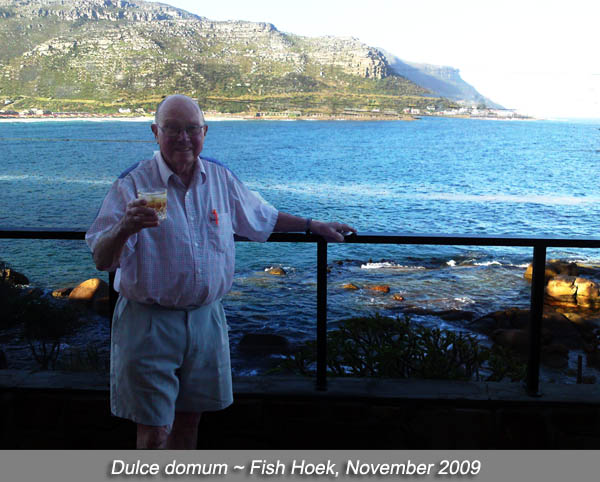
|
| |
|
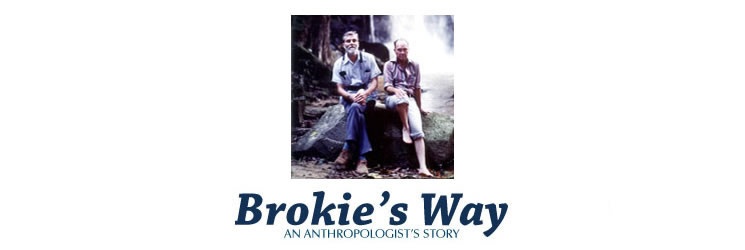
to access the personal writings
of David Brokensha please click on one of the above links.
© DWBrokensha 2005-2009
|
|
|